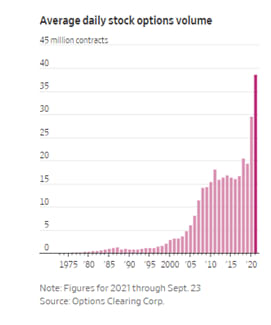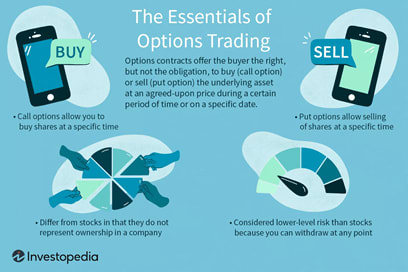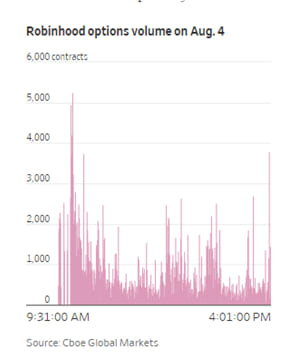Record highs interspersed with swift-but-brief drops: And so it goes, still. The stock markets have done what even I didn’t think they could do, marching on with an essentially uninterrupted and almost absurd level of irrational exuberance.
That got me thinking about what’s behind it: What was I missing that makes this bull run seemingly so unstoppable?
Then it hit me, as it did other traders and analysts: Not only are there sources of hidden leverage that I hadn’t unpacked in several posts on hidden leverage (see
this and
this if you missed them), but what’s being leveraged — stock options — are gaining enormous momentum, to the point where options deals often outpace actual share trades on any given day — the first time in history that this has occurred. And while this isn’t the only source of irrational exuberance that we see in the markets, it’s certainly a contributor.
Stock options are a type of derivative and I haven’t covered derivatives in this blog because it’s a pretty complex area of investing. Still, since the “Robin Hooding” of the markets has opened up derivatives to retail-level investors and the markets are bonkers in part because of options, I thought it’d be interesting to do an overview this week.
A quick note: For anyone who isn’t familiar with stock options, I’ll do a quick overview first, so that the latter part of this post makes a little more sense and for this introduction, I’ll lean on
Investopedia for definitions. If this topic is second nature to you, though, feel free to move ahead.
What are derivatives?
Derivatives are secondary securities whose value is solely based (derived) on the value of the primary security that they are linked to – called the underlying. Typically, derivatives are considered advanced investing.
There are two classes of derivative products: “lock” and “
option.” Lock products (e.g. swaps, futures, or forwards) bind the respective parties from the outset to the agreed-upon terms over the life of the contract.
Option products (e.g.
stock options), on the other hand, offer the holder the right, but not the obligation, to buy or sell the underlying asset or security at a specific price on or before the option’s expiration date.
While a derivative’s value is based on an asset, ownership of a derivative doesn’t mean ownership of the asset. Futures contracts, forward contracts, options,
swaps, and
warrants are commonly used derivatives.
What are stock options?
There are two primary facets to stock options: puts and calls.
Turning to Investopedia again,
puts are “…a contract giving the owner the right, but not the obligation, to sell–or sell short–a specified amount of an
underlying security at a pre-determined price within a specified time frame. This pre-determined price that buyer of the put option can sell at is called the
strike price.”
Conversely, “
Call options are financial contracts that give the option buyer the right, but not the obligation, to buy a stock, bond,
commodity, or other asset or instrument at a specified price within a specific time period. The stock, bond, or commodity is called the
underlying asset. A call buyer profits when the underlying asset increases in price.”
A put, then, is an asset owner’s right to sell and the associated contract and a call, then, is a buyer’s option to buy and the associated contract. “Option,” therefore, means that there is no obligation either to buy or sell, simply the right to do so.
With that very brief introduction, let’s move on.
What are the potential upsides and downsides to stock options?
Everything about the stock markets has upsides and downsides, primarily that when things go your way, you can make a lot of money. When things don’t, you can lose your shirt (and a lot more).
Stock options provide investors with a way to play the market with potentially significant gains while mitigating the risks — all while using what is essentially hidden leverage.
For example, when investors purchase call options, they pay a premium, which is a per-share fee for the option contract. At that point, they don’t have to actually purchase contracted stocks — instead, they have time to watch the markets and make their moves, or not:
- If an investor executes the purchase, then they own the underlying asset (stocks, in this case).
- If an investor walks away from a call option because the stock didn’t perform as they’d hoped when they purchased the call option and instead lets the call option expire, then all they lose is the premium.
Given this, it’s easy to see why stock options are attractive to many investors, particularly now, those who have relatively smaller sums to play with, aka the retail-level investors. And here’s what that looks like, as reported in
The Wall Street Journal:
At times, options trading has dwarfed activity in stocks, creating leverage that traders and analysts say stands to accentuate both up and down moves in the market.
Nine of 10 of the most-active call-options trading days in history have taken place in 2021,
Cboe Global Markets data show. Almost 39 million option contracts have changed hands on an average day this year, up 31% from 2020 and the highest level since the market’s inception in 1973, according to figures from the Options Clearing Corp.
How does options trading impact volume and pricing?
The skyrocketing volume of options trades is remarkable not only for the volatility it causes in the markets, but because it also further pushes up the price of stocks, primarily when traders hedge against the puts and calls.
Which brings me to my next point and why I find this unnerving.
Is there any potential danger to the volume of stock options being traded daily?
Right now, we’re facing a lot of headwinds: Among them are the potential U.S. government default, the debt-ceiling crisis, inflation, supply-chain challenges and ongoing reverberations and uncertainty via the world’s second-largest economy, China. And, of course, there’s still the pandemic.
All of this uncertainty now makes me feel uneasy about where we’re headed — not that I foresee significant doom, but I can imagine something of a wake-up call, especially for many of the retail-level investors who are intoxicated by the potential to win big. It’s a highly charged and extremely leveraged investment atmosphere and it leaves me feeling anxious, at best.
I’ll sum it up simply: Reading the tape, I believe that we’re caught in a strange cycle — a cyclone, really — in which investors are buying calls because stocks are going up, which leads to the traders who are selling options to buy shares to hedge their positions, which has created an echo chamber within the markets. To me, there’s danger in anomalies that can unwind significantly and rapidly. It’s also something that I didn’t see happening before and yet another indicator of significant potential issues in the markets.
Eventually, there has to be an outlet for this extreme energy and volatility. I just don’t know yet what that will be.









